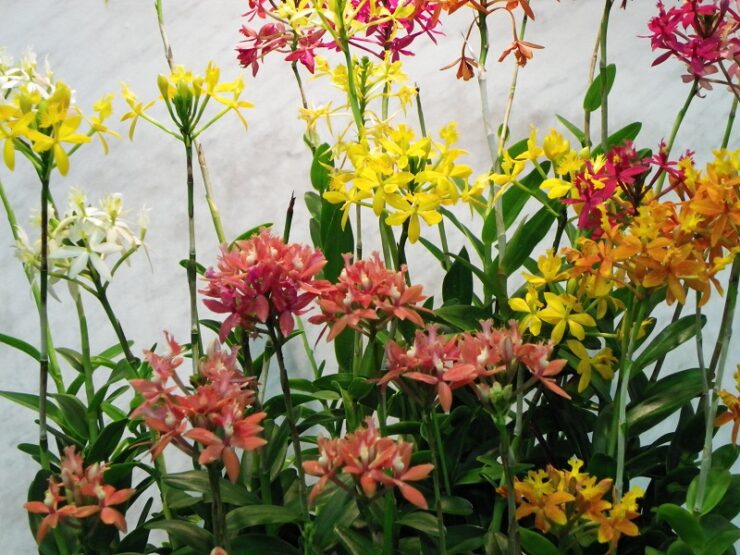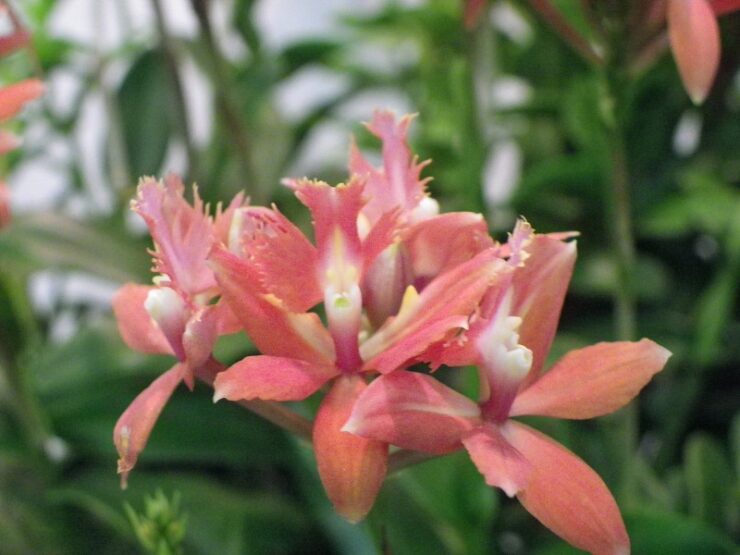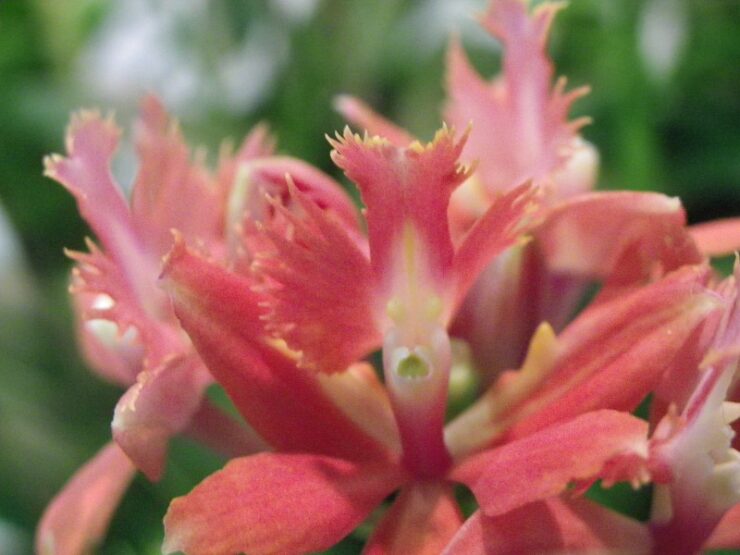In this article, we will explore the captivating allure and significance of the November birth-orchid, known as the Epidendrum, which holds a cherished position in the realm of flowers and is highly esteemed for its striking appearance and cultural symbolism.
The Epidendrum, also referred to as the “crucifix orchid,” is a popular choice among orchid enthusiasts due to its vibrant, star-shaped flowers that come in a variety of hues, such as orange, red, yellow, pink, and purple.
Beyond its aesthetic charm, this orchid also holds cultural importance in different parts of the world, with some societies associating it with love, beauty, and strength, while others view it as a symbol of resilience and adaptability.
As we delve deeper into the November birth-orchid, we will uncover the various meanings and customs linked to this extraordinary flower.
History of the Orchid

The Epidendrum is a fascinating genus of orchids with a rich history dating back centuries. Native to the tropical and subtropical regions of the Americas, Epidendrum orchids have captivated the hearts of people across the globe with their vibrant, star-shaped flowers.
The name Epidendrum is derived from the Greek words “epi” and “dendron,” which mean “upon” and “tree,” respectively. This refers to the epiphytic nature of many Epidendrum species, which grow on trees or other plants in their natural habitat.
The genus was first described by the Swedish botanist Carl Linnaeus in 1763, and since then, the number of species classified under Epidendrum has grown to over 1,000, with countless hybrids and varieties.
During the Victorian era, the fascination with orchids, including Epidendrums, reached new heights. Collectors and horticulturists from Europe ventured into the tropical regions of the Americas in search of rare and exotic species. This period, known as “Orchidelirium,” saw a boom in the cultivation and trade of orchids, with Epidendrums being a prominent part of this craze.
As orchid cultivation techniques improved over time, Epidendrums became more accessible and popular among hobbyists. Today, they are widely cultivated in various parts of the world, with enthusiasts breeding new hybrids to create stunning combinations of colors, patterns, and shapes.
The Epidendrum orchid’s popularity is not only due to its stunning appearance but also its resilience and adaptability. Many species can tolerate a range of growing conditions, making them an excellent choice for both novice and experienced growers.
Symbolism and Cultural Significance
- Epidendrum orchids have long held symbolic and cultural significance across various societies and traditions. Their vibrant colors, intricate shapes, and the wide variety of species they display have made them captivating and meaningful symbols in different contexts. Let’s explore some of the key aspects of Epidendrum orchids’ symbolism and cultural significance:
- Love and beauty: Epidendrum orchids, with their vibrant and eye-catching appearance, are often associated with love and beauty. Their stunning flowers evoke a sense of elegance and romanticism, making them popular choices for wedding decorations, bouquets, and as gifts for loved ones.
- Strength and resilience: Epidendrum orchids are known for their ability to adapt to a variety of growing conditions and environments. This resilience has led to their association with strength and determination. The symbolism of strength is particularly fitting for the November birth orchid, representing those born in this month as strong and adaptable individuals.
- Fertility and abundance: In some cultures, Epidendrum orchids are believed to symbolize fertility and abundance. This is attributed to their prolific flowering habit and the wide variety of species and hybrids found within the genus. They are often used in ceremonies and rituals

Medicinal Purposes
Orchids possess a rich history of utilization as both medicinal and spiritual aids, long before contemporary individuals began cultivating and marketing them. These flowers contain various substances with tonic, astringent, analgesic, antipyretic, and anti-inflammatory properties, traditionally employed in treating an extensive range of ailments.
Specifically, orchid flowers, particularly the Epidendrum Orchid or the “Crucifix Orchid,” have been a prevalent ingredient in traditional Chinese medicine, where they were employed to treat conditions like lung diseases, severe coughs, kidney diseases, eye diseases, stomach deficiencies, and to nourish the Yin and enhance the production of body fluids.
Even today, orchids continue to be used for medicinal purposes in China, typically in the form of tea.
Fun Facts
- Epidendrum orchids are part of a large genus, with over 1,000 species and many more hybrids. They can be found from the southeastern United States to Argentina, making them incredibly diverse in their growth habits and appearances.
- These orchids are often called “Crucifix Orchids” due to the unique shape of their lip, which resembles a cross. This feature has made them popular and easily recognizable among orchid enthusiasts.
- Epidendrum orchids are known for their bright, vibrant colors, which include shades of red, orange, yellow, pink, and purple. These vivid hues make them a popular choice for adding a pop of color to gardens and floral arrangements.
- They are considered easy to grow and can adapt to a wide range of environmental conditions. As a result, Epidendrum orchids are an excellent choice for novice gardeners or those looking to expand their orchid collection.
- Epidendrum orchids can grow as epiphytes, lithophytes, or terrestrials, meaning they can thrive on trees, rocks, or in soil. This adaptability allows them to flourish in various habitats and contributes to their widespread distribution.
- Some species of Epidendrum orchids are known for their reed-like stems and attractive foliage, making them visually appealing even when not in bloom.
- These orchids have a unique pollination mechanism. The pollinator must push past the lip of the flower to access the nectar, which causes the pollen to attach to the pollinator’s body. When the pollinator visits another Epidendrum flower, the pollen is transferred, resulting in successful pollination.
- The November birth orchid, Epidendrum, symbolizes strength, wisdom, and beauty. Gifting an Epidendrum orchid to someone born in November can be a thoughtful gesture, representing these positive qualities.
Epidendrum Orchid Care
Caring for Epidendrum orchids is relatively simple, as they are known for their adaptability and hardiness. Follow these guidelines to help your Epidendrum orchid thrive:

Light:
Epidendrum orchids enjoy bright, indirect light. Place them near a window with filtered sunlight or in a shaded area outdoors if the climate permits. Direct sunlight can scorch their leaves, so ensure the light is not too intense.
Temperature:
These orchids can tolerate a wide range of temperatures, but they generally prefer intermediate to warm conditions. Daytime temperatures between 65-85°F (18-29°C) and nighttime temperatures around 55-65°F (13-18°C) are ideal.
Water:
Water your Epidendrum orchid when the potting medium is almost dry. Overwatering can lead to root rot, so it’s essential to let the medium dry out slightly between waterings. Depending on your environment, this may be once a week or less frequently.
Humidity:
Epidendrum orchids appreciate a moderate humidity level of around 40-60%. You can maintain adequate humidity by placing the plant on a humidity tray or using a room humidifier.
Potting medium:
A well-draining potting mix is crucial for Epidendrum orchids. You can use a mix of bark, perlite, and sphagnum moss, or purchase a pre-made orchid mix. Repot your orchid every 1-2 years, as the potting medium tends to break down over time.
Fertilizer:
Feed your Epidendrum orchid with a balanced orchid fertilizer (20-20-20) diluted to half strength every 2-4 weeks during the growing season. Reduce fertilization to once a month during the winter months.
Pruning:
Remove spent flower spikes to encourage new growth and maintain the orchid’s overall health. You can also trim back any dead or yellowing leaves.
By following these care guidelines, your Epidendrum orchid should flourish and provide you with stunning blooms for years to come.
FAQ
Are Epidendrum orchids fragrant?
Some species of Epidendrum orchids produce fragrant flowers, while others do not. The scent can vary from mild and sweet to more intense, depending on the species and growing conditions.
Can Epidendrum orchids be grown indoors?
Yes, Epidendrum orchids can be grown indoors, provided they receive adequate light, humidity, and proper care. Place them near a window with filtered sunlight and maintain a consistent temperature and humidity level for the best results.
How often do they orchids bloom?
Epidendrum orchids typically bloom once a year, although some species may produce flowers more frequently. With proper care, their blooms can last for several weeks or even months.
Can I propagate Them?
Epidendrum orchids can be propagated through division or by growing them from seed. Division is the more straightforward method, as it involves separating the plant into smaller sections, each with its roots and pseudobulbs. Growing Epidendrum orchids from seed is more challenging and requires sterile conditions and specialized techniques.
Are Epidendrum orchids toxic to pets?
While orchids, in general, are considered non-toxic to pets, it is best to keep them out of reach to prevent ingestion. Some pets may be sensitive or allergic to specific plant species, so it’s always a good idea to monitor your pet’s behavior around new plants.
How can I encourage my Epidendrum orchid to bloom?
To encourage your Epidendrum orchid to bloom, provide it with optimal growing conditions, such as adequate light, temperature, humidity, and proper fertilization. Additionally, ensure that the plant has a suitable potting medium and that it is not root-bound. Sometimes, a slight change in temperature or light exposure can help trigger blooming.
Do they require a specific pot or container?
Epidendrum orchids do not require a specific type of pot or container, but they do need a well-draining potting medium. You can use plastic or clay pots with drainage holes, as long as the pot is appropriately sized for the orchid’s root system. Some growers prefer to mount their Epidendrum orchids on slabs or in hanging baskets, particularly for epiphytic species.
Conclusion
Epidendrum orchids, the captivating November birth orchid, hold a special place in the world of flowers due to their striking appearance, resilience, and rich cultural symbolism. With their vibrant colors and intricate shapes, they have become a favorite among orchid enthusiasts and continue to be cherished for their associations with love, beauty, strength, and adaptability.
Caring for Epidendrum orchids is relatively simple, making them an excellent choice for both novice and experienced growers. By providing the appropriate light, temperature, humidity, and potting conditions, you can enjoy the stunning blooms of these remarkable orchids for years to come.
Whether you’re gifting an Epidendrum orchid to a loved one born in November or simply admiring its beauty in your own living space, this exceptional flower is sure to leave a lasting impression.
If you like this article read more here about April and October birth orchids.
